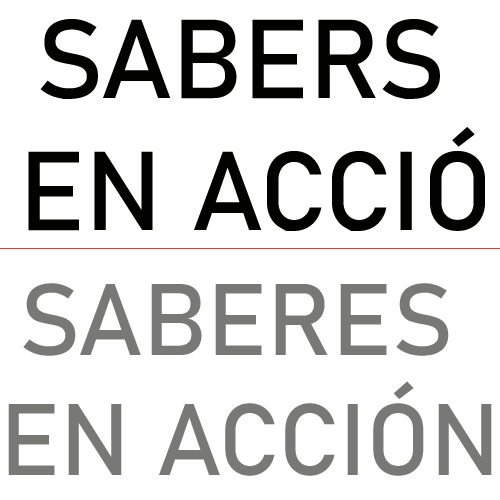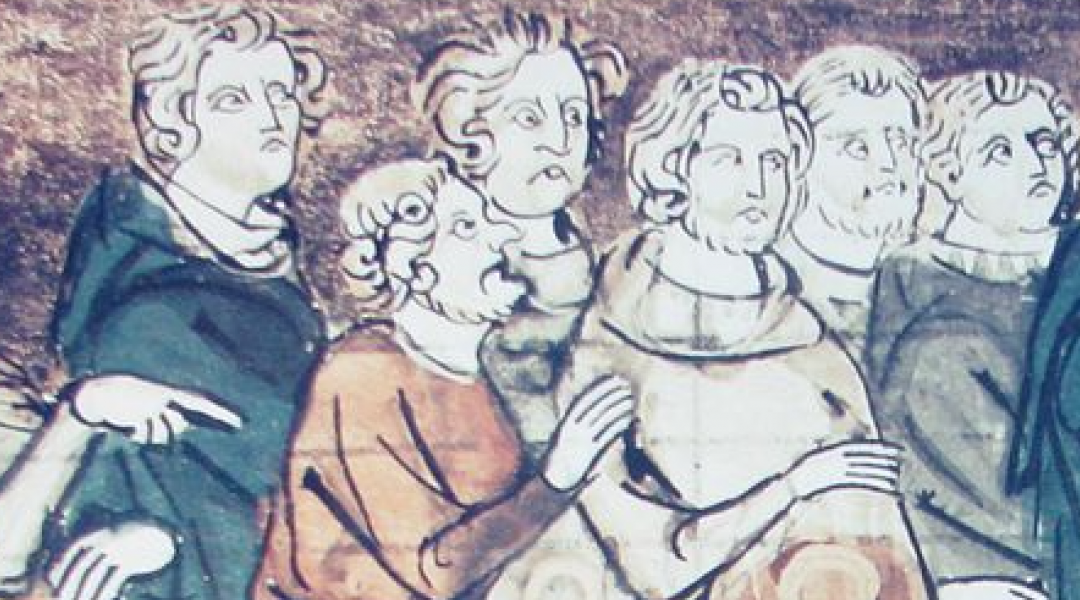—The crossroads of cultures, languages and religions in the Middle Ages: Muslims, Jews and Christians in the production of scientific knowledge.—
We must bear in mind that, during the Middle Ages, Europe was a scene of profound and diverse cultural contact. Over much of this period, Muslims, Jews and Christians ─ with many of the latter, those of the East, showing great differences from those of the West ─ lived closely together, shared knowledge and enriched each other. Crusades and wars, as well as commercial and economic interests, explain many of these contacts. Whether they were subjects or rulers, the truth is that coexistence was fruitful over a long period. It is also true that waves of intransigence and violence, particularly in the late medieval kingdoms with pogroms and the development of the Inquisition, broke up many of these possibilities for intellectual exchange.
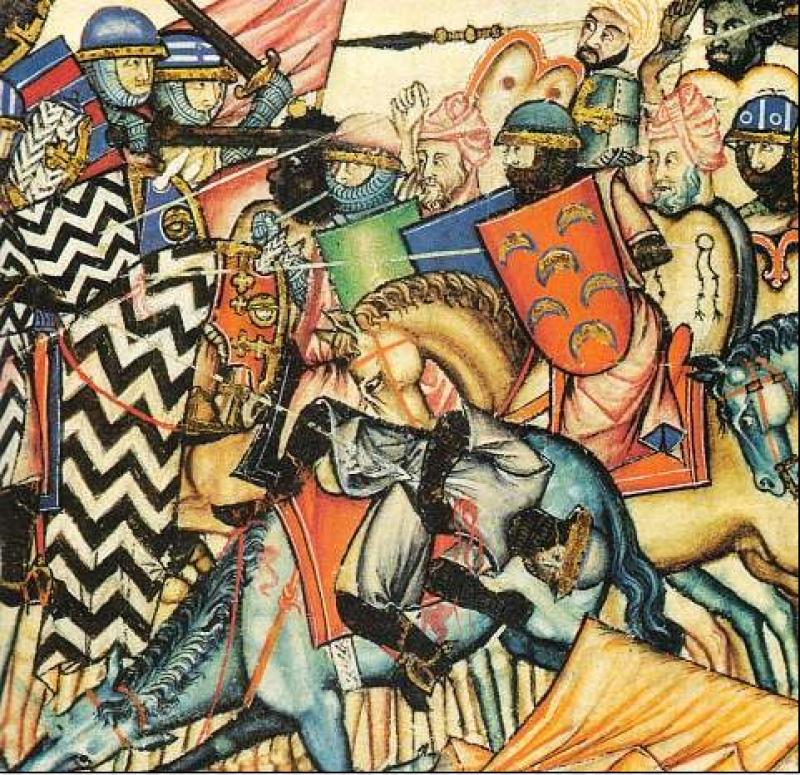
Battle between Christians and Muslims. Cantigas de Santa María by Alfonso X the Wise, nº 63, San Lorenzo del Escorial, 13th century Wikipedia.
The most recent studies on Islamic science and its influence on Western science show that there was a privileged space for this interaction in the Early Middle Ages (the eleventh to the thirteenth century), which was the lands of the Middle East, the setting for the crusades. For example, Antioch, a cultural centre of the first order, which was captured during the first crusade and had a rich and cosmopolitan society with mostly Christians, generated its own form of intellectual exchange involving three languages: Greek, Arabic and Latin. In that crusader kingdom, some individuals dedicated themselves to translation. The commercial networks established by the Europeans, a very clear example being the case of the citizens of Pisa, were one of the key elements in these processes of linguistic transfer. Many individuals travelled to the East where they came into contact with the works of Galen, Aristotle and Ptolemy, and took advantage of their knowledge of Greek and Arabic to obtain all this content unpublished in the West. The case of medicine is revealing.
The comparison between the texts used until the twelfth century by Arab physicians with the Latin ones makes it possible to say that there was a great difference in the area of medical theory and practice before the movement of translations that would occur throughout the next century. Thus, the physicians who were active in the lands of the East in the service of Latin princes, whether Jews, Christians or Muslims, had different cultural and scientific references, clearly superior in the case of the latter. To what extent did the confrontation of these types of knowledge involve a transfer of knowledge? It can be assumed that the discovery of Arab medicine, often more effective, with a richer pharmacopoeia and supported by an extensive basis of scientific treatises, promoted a new social demand to which translators from other places responded.
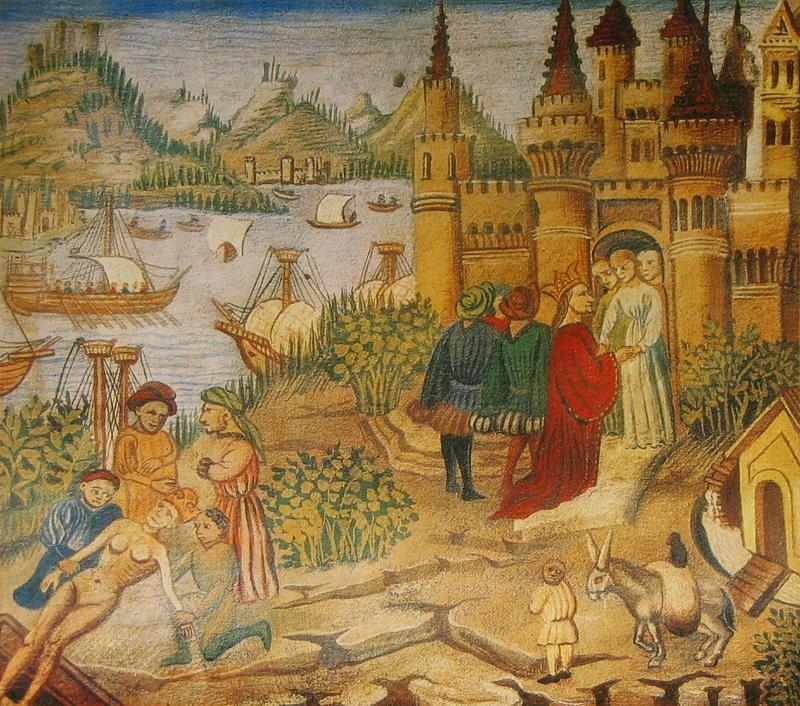
Medical school of Salerno, after a miniature of Avicenna’s Canon, Biblioteca Universitaria di Bologna, 15th century. Wikipedia.
While the crusades were taking place in the Holy Land, a movement of translation into Latin was taking place in southern Italy, in Salerno, during the eleventh century, and in Toledo in the twelfth century. In the second city especially, a group of individuals from very diverse backgrounds and religions, as their names indicate, engaged in arduous translation work that would enable access to many classical sources that were unknown until they were taken from Islam.
Christian military expansion and its colonisation would change the landscape. In the Christian kingdoms on the shores of the Mediterranean, the three religions converged, with shared common interests in useful knowledge put into practice in everyday life. It is worth noting the deep admiration that the physicians and scientists (astrologers, alchemists) of these religions professed and, above all, the mutual trust in their competence. It can be said that they worked side by side to solve issues of general interest. A monk in a monastery or a secular cleric could read, encourage the translation of and comment on Arab authors; a hospital patient ‒ let us not forget that it was an institution based on Christian charity and not created for medical practice ‒ could be attended by a Muslim empiricist; a nobleman or a monarch could seek assistance from prestigious Jewish or Muslim physicians or grant them a license to practice the medicine or field of knowledge in which they excelled, regardless of whether they themselves had passed prohibitions relating to the practice of medicine by these minorities.
The case of Jewish doctors is particularly significant. In many parts of Western Europe, particularly in the Hispanic kingdoms, they were highly appreciated by Christians, and nobles and kings often demanded their services even though most of their physicians, physicists and surgeons were Christians. We also know of Christian doctors who treated Jews. What we have no information about is whether the latter acted on Muslims. Thus, the prohibitions and the continuous pleas made by preachers did nothing to stop Christian patients going to Jewish doctors. What mattered when dealing with illness, and what guided the decision of the sick, was the person, his expertise and his professional prestige.

Materia medica by Dioscorides, Topkapu Saray-Museum, Istanbul, 1229. Wikimedia.
In the countries of the western Mediterranean, especially in Provence, the Languedoc region and the Kingdom of Aragon, the Latin scholastic education system had developed in such a way that it became a model to be imitated and a resource to be exploited. At least it was seen in this way by a rationalist minority (natural philosophers or rationalist physicists) of Jewish medical practitioners. One of the products most appreciated by Christian and Jewish physicians was the regimina sanitatis, guides to keep health in optimal condition, aimed at the elite. This is shown by the various Hebrew translations made during the second half of the fourteenth century. These texts were progressively spread among wider audiences who saw in them the possibility to govern their lives according to Galen’s principles. The Jewish minority thus knew how to explicitly appreciate the intellectual achievements of scholastic medicine developed by Christians between the thirteenth and fifteenth centuries, without renouncing their Hebrew background, seeing them as the scientific basis for effective medical practice. This basis was stripped of all doctrinal religious content and was able to be reduced to ideologically neutral contents. Nevertheless, we also know that the Muslim kings of Granada in the fourteenth century also appreciated Christian doctors and at times summoned them to treat their diseases.
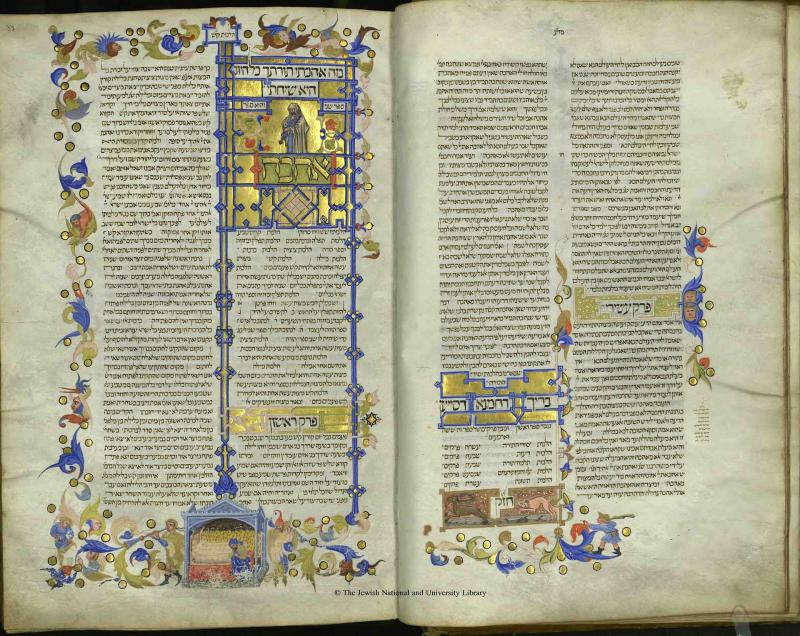
Mishné Torá (Maimonides, 1180), Sephardic Hebrew manuscript, illuminated by Matteo di Ser Cambio in Perugia in 1400, National Library of Israel, Jerusalem, c. 1340. Wikipedia.
In the case of medieval medical Galenism, the Arabic language became a suitable and rigorous vehicle of scientific communication, surviving in southern Europe until the Renaissance. Those who knew the language could access medical texts of great practical value from any branch of knowledge that we would today call scientific. During the twelfth and thirteenth centuries, manuscripts in Arabic circulated in the kingdoms of Castile and Aragon. The users of these texts were members of the three religious communities that coexisted in the Christian kingdoms of the Iberian Peninsula during these centuries. The three cultures had been able to reconcile their faith with Aristotelian natural philosophy, not without arduous debates and tensions (Albertus Magnus and Thomas Aquinas succeeded in the thirteenth century; Maimonides for Judaism in the twelfth century; while Islamic culture had already succeeded centuries before that).

Expulsion of the Jews from France in 1182, Grandes Chroniques de France (1321). Wikipedia.
However, as the fourteenth century progressed, the pressure on the Jewish and Muslim communities grew worse, as a result of the instigation of religious authorities and the limitations imposed by civil authorities. At the end of the century, the assault on the Jewish Quarters with crimes and the destruction of property mortally wounded this tradition. Some physicians and scholars converted to Christianity. Their reputation continued. Some would end up being condemned by the Inquisition and burnt at the stake as crypto-Jews. Others always lived under suspicion. The Muslim community of the Iberian Peninsula, which still struggled to maintain the ancient knowledge of their science, ended up being forcibly converted. The Moors could no longer maintain the knowledge of their ancestors, and little by little their practices degenerated into the world of pure belief, faith healers and other arts that were always viewed with suspicion by the authorities.
Carmel Ferragud
IILP-UV
How to cite this paper:
Ferragud, Carmel. Worlds in contact. Sabers en acció, 2020-11-25. https://sabersenaccio.iec.cat/en/worlds-in-contact/.
Find out more
You can find further information with the bibliography and available resources.
Recommended reading
García Ballester, Luis; López Piñero, José Mª; Peset, José Luis, eds. Historia de la ciencia y de la técnica en la Corona de Castilla, vols. Vols. 1-2 (Middle Ages). Valladolid: Junta de Castilla y León, 2002.
Lindberg, David C. Los inicios de la ciencia occidental. La tradición científica europea en el contexto filosófico, religioso e institucional (desde el 600 a.C. hasta 1450). Barcelona-Buenos Aires-México: Paidós; 2002.
Studies
Caballero-Navas, Carmen. The care of women’s health and beauty: an experience shared by medieval Jewish and Christian women. Journal of Medieval History, 34 (2008), 146-163.
Draelants, Isabelle; Tihon, Anne; Van den Abeele, Baudoin, eds. Occident et Proche-Orient : Contacts scientifiques au temps des Croisades. Actes du colloque de Louvain-la-Neuve, 24 et 25 mars 1997. Turnhout: Brepols; 2000.
Edgington, Susan B. Oriental and Occidental medicine in the crusader states. In: Kostick, Conor, ed. The Crusades and the Near East. London-New York; Routledge; 2011, p. 189-215.
García Ballester, Luis. Historia social de la medicina en la España de los siglos XIII al XVI. Madrid: Akal; 1976.
García Ballester, Luis. Medicine in a Multicultural Society. Aldershot: Ashgate; 2001.
Grant, Edward. Science and religion, 400 B.C. to A.D. 1550: from Aristotle to Copernicus. Baltimore: Johns Hopkins University Press; 2006.
Pormann, Peter E.; Savage-Smith, Emilie. Medieval Islamic Medicine. Edinburgh: EUP; 2007.
Shatzmiller, Joseph. Jews, medicine and medieval society. Berkeley-London: University of California Press; 1994.
Websites and other resources
Sciència.cat DB Base de datos de la ciencia y la técnica en catalán en la Edad Media y el Renacimiento [Updated in 2020; accessed 17 June 2020]. Available here.
Medicine in the medieval Islamic world. Wikipedia. The Free Encyclopedia [Updated 10 June 2020; accessed 17 June 2020]. Available here.
Regesta Imperii. Akademie der Wisshenschaften und der Literatur Mainz [Updated in 2020; accessed 17 June 2020]. Available here.
